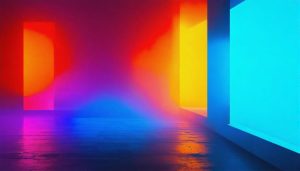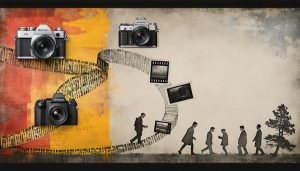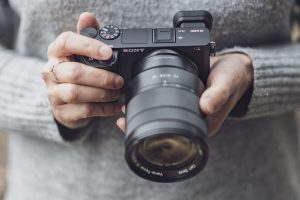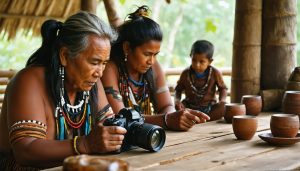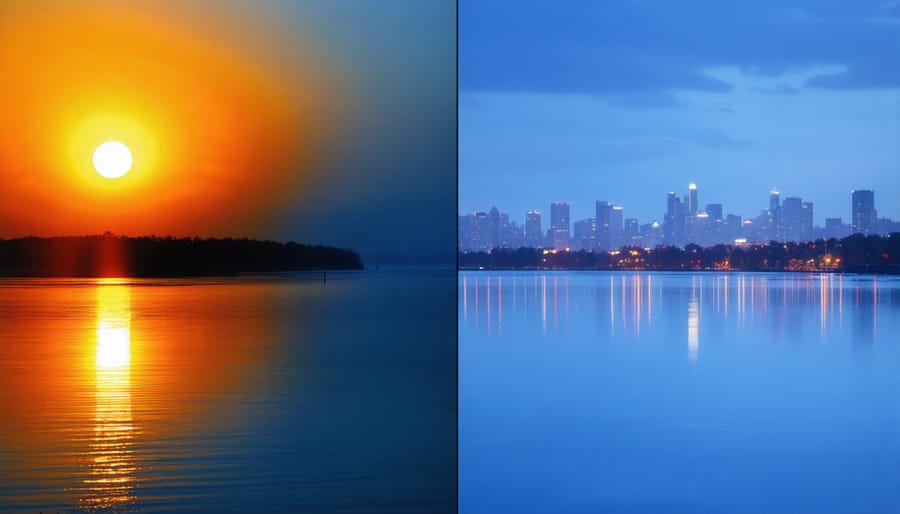
Photography transcends mere image capture – it’s a delicate dance between technical precision and artistic vision. When photographers master this intersection, they create compelling visual effects that move beyond documentation into the realm of fine art. Every frame tells a story through deliberate choices in composition, lighting, and timing.
The artistry in photography emerges from understanding how to manipulate both the technical and emotional elements of an image. Master photographers don’t just capture what exists – they interpret scenes through their unique creative lens, transforming ordinary moments into extraordinary visual statements. This mastery requires developing an eye for detail, learning to see light as a sculptural tool, and understanding how subtle adjustments in technique can dramatically alter the emotional impact of an image.
Whether working in vibrant color or classic black and white, true photographic artists recognize that their camera is simply a starting point. The real magic happens in the split-second decisions about framing, the patient wait for perfect light, and the intuitive understanding of how technical choices serve the creative vision. This artistic approach elevates photography from a mechanical process to a powerful medium for personal expression and storytelling.
The journey toward photographic artistry begins with mastering fundamentals but ultimately leads to developing a distinctive visual voice that speaks through every image you create.
The Dance of Light and Shadow
Understanding Quality of Light
Light is the cornerstone of artistic significance in photography, and understanding its qualities can transform your images from simple snapshots to compelling visual stories. Let’s explore the two main characteristics of light that photographers work with: quality and source.
Hard light creates strong, defined shadows and high contrast, perfect for dramatic portraits or architectural photography. Think of bright sunlight at noon or a bare flash – these sources produce sharp edges and bold statements. Soft light, on the other hand, wraps around subjects with gentle transitions and minimal shadows, ideal for flattering portraits or moody landscapes. You’ll find soft light on overcast days or when using diffused artificial lighting.
Natural light offers its own charm and challenges. Golden hour, just after sunrise or before sunset, bathes subjects in warm, directional light that’s perfect for landscapes and portraits. Blue hour, during twilight, provides ethereal, even illumination that’s excellent for cityscapes and mood pieces. Artificial light gives you more control – studio strobes, LED panels, or even simple speedlights can help you craft precise lighting scenarios regardless of time or weather.
The key is learning to see light rather than just look at it. Notice how it falls across surfaces, creates depth through shadows, and influences the emotional impact of your image. Practice observing these qualities in everyday scenes, and you’ll develop an intuitive understanding of how to use light to enhance your photographic vision.
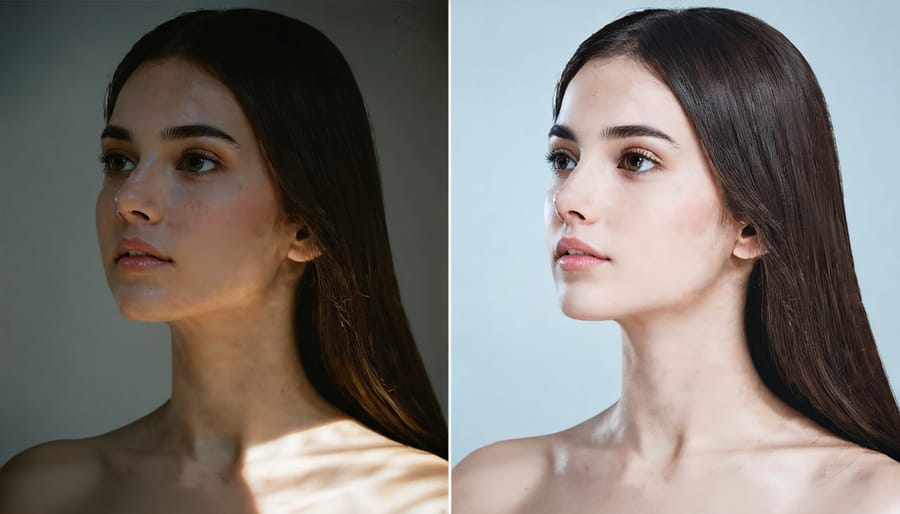
The Power of Shadows
Shadows are the unsung heroes of compelling photography, transforming flat images into dynamic works of art that captivate viewers. When wielded thoughtfully, shadows add a mysterious quality to photographs, creating depth and dimension that draw the eye through the frame.
The interplay between light and shadow is what gives photographs their three-dimensional quality. Deep shadows can frame a subject, leading viewers’ attention exactly where you want it to go. Think of shadows as nature’s vignette, organically directing focus while adding dramatic flair to your compositions.
The quality of shadows matters tremendously. Hard shadows, created by direct sunlight or artificial lighting, produce bold, graphic elements with crisp edges. These work beautifully in architectural photography or when you want to create striking geometric patterns. Soft shadows, on the other hand, offer subtle gradients that can add depth without overwhelming the subject – perfect for portrait photography and still life images.
To harness shadows effectively, start by observing how they fall naturally in your environment. Look for interesting patterns created by window blinds, tree branches, or architectural elements. Position your subject strategically in relation to these shadow patterns. Sometimes, moving just a few inches can transform an ordinary shot into something extraordinary.
Remember that shadows aren’t just dark areas to be avoided – they’re powerful tools that can convey mood, create visual interest, and add that professional polish to your photographs. Embrace them as essential elements of your photographic storytelling.
Creative Techniques for Light Manipulation
Natural Light Mastery
Natural light is photography’s most powerful yet unpredictable tool, offering endless creative possibilities for those who learn to harness it effectively. The golden hour, occurring during the first and last hours of daylight, bathes subjects in warm, directional light that creates long, dramatic shadows and adds depth to your compositions. During this magical time, even ordinary scenes transform into extraordinary photographs.
The blue hour, happening just before sunrise and after sunset, presents a different palette altogether. This brief window provides soft, ethereal light with cool tones perfect for cityscapes and landscape photography. The balanced ambient light during this period helps prevent harsh shadows and blown-out highlights.
Mastering challenging lighting conditions requires both technical knowledge and creative problem-solving. When dealing with harsh midday sun, look for natural diffusers like clouds or tree canopies. Alternatively, position your subject in open shade to achieve even lighting while maintaining natural color temperature. Backlit scenes can be particularly tricky, but they offer opportunities for creating striking silhouettes or capturing beautiful rim lighting effects.
Weather conditions greatly influence available light. Overcast days provide nature’s softbox, perfect for portrait photography and reducing contrast in landscape shots. Rainy days create reflective surfaces and moody atmospheres, while foggy conditions diffuse light beautifully, adding mystery to your images.
To work effectively with natural light, observe how it interacts with your environment throughout the day. Practice reading the quality, direction, and intensity of light, and learn to anticipate how these factors will affect your final image. Remember that sometimes the most challenging lighting situations can lead to the most compelling photographs.
Artificial Light Artistry
While natural light offers its own beauty, mastering artificial lighting opens up a whole new realm of possibilities to unleash your creative vision. Whether you’re working in a studio or on location, understanding how to manipulate artificial light sources gives you complete control over your photographic environment.
Flash photography serves as your primary tool for creating dramatic effects. Speedlights offer portability and versatility, while studio strobes provide more power and consistency. The key lies in understanding how to modify these light sources effectively. Softboxes diffuse harsh light, creating gentle transitions perfect for portraits. Umbrellas spread light broadly, ideal for group shots. Beauty dishes deliver that characteristic wraparound light with a crisp edge that fashion photographers love.
Continuous lighting, including LED panels and traditional tungsten lights, allows you to see exactly how light falls on your subject before pressing the shutter. This makes them particularly valuable for beginners learning light placement and for video work. Modern LED panels offer adjustable color temperature, enabling you to match ambient light or create intentional color contrasts.
Light modifiers are your artistic tools for shaping light. Consider them your photographic paintbrushes. Grid spots control light spread, creating dramatic spotlighting effects. Barn doors let you precisely direct light, preventing unwanted spill. Color gels transform the mood of your images – warm gels can simulate sunset, while cool tones can create moonlight effects.
The true artistry comes from combining these tools. Try using a main light with a softbox for overall illumination, an edge light with a grid for separation, and a subtle fill light bounced off a reflector for shadow detail. Remember that darkness is equally important – strategic shadows can add depth and drama to your compositions.
Start simple with one light source and gradually build complexity as you gain confidence. Experiment with light placement, power ratios, and different modifiers. Take test shots, analyze the results, and adjust accordingly. Soon you’ll develop an intuitive understanding of how to craft light to achieve your artistic vision.
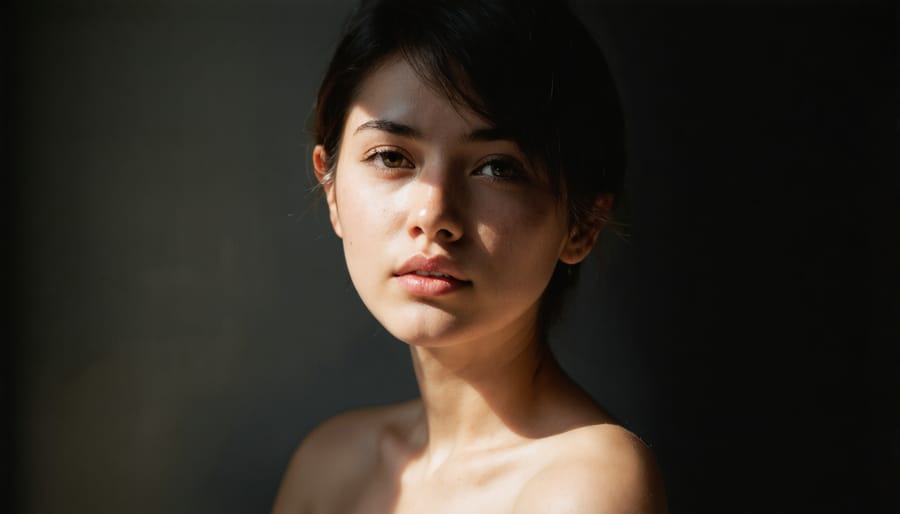
Shadow Play Techniques
Dramatic Contrast
Dramatic contrast in photography is a powerful tool that can transform ordinary scenes into compelling visual narratives. By deliberately working with strong shadows and highlights, photographers can create images that command attention and evoke deep emotional responses from viewers. This technique, when combined with other composition techniques, can elevate your photography to new artistic heights.
To create high-contrast images, start by identifying scenes with naturally occurring strong light and shadow patterns. Early morning or late afternoon sun creates long, dramatic shadows that can serve as leading lines or frame your subject. In urban environments, look for architectural elements that cast distinct shadows, creating geometric patterns that add depth and visual interest to your compositions.
The key to mastering dramatic contrast lies in exposure control. Consider exposing for the highlights and allowing shadows to fall into deep blacks, or alternatively, expose for the shadows to create striking silhouettes. Modern cameras’ spot metering modes are particularly useful for this technique, helping you achieve precise exposure in challenging lighting conditions.
Post-processing plays a crucial role in enhancing contrast. While you should aim to capture as much contrast in-camera as possible, tools like curves adjustment and selective dodging and burning can help fine-tune the balance between light and dark areas. Remember that contrast isn’t just about black and white – even color photography can benefit from strong tonal differences that guide the viewer’s eye through the frame.
Experiment with different times of day and weather conditions to discover how changing light affects the mood and impact of your high-contrast images. Rainy days can create stunning reflections and dramatic sky conditions that naturally enhance contrast in your scenes.
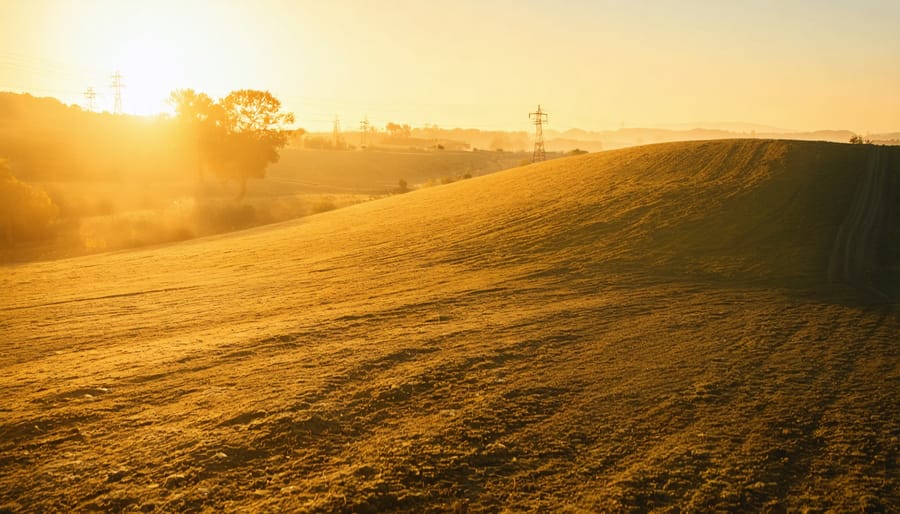
Subtle Shadow Details
In the interplay between light and shadow lies the true magic of photography. Shadows aren’t just dark areas in your images; they’re powerful tools that can transform an ordinary photograph into a compelling visual narrative. When working with shadows, it’s the subtle details that often create the most subtle artistic effects and emotional resonance.
Consider the gentle gradation of shadows falling across a subject’s face during golden hour. These delicate transitions can reveal texture, emphasize form, and create depth that draws viewers into the image. The key is to look for shadows that softly wrap around objects rather than create harsh, abrupt transitions.
To capture these nuanced shadow details effectively, start by exposing for the highlights and paying careful attention to your histogram. Often, slightly underexposing your image can help preserve those delicate shadow transitions that might otherwise be lost. Modern camera sensors excel at recovering shadow detail, but it’s still crucial to get it right in-camera whenever possible.
Try experimenting with different light positions and intensities. Place your subject near a window or use a diffused light source to create gentle shadows that reveal rather than conceal. Pay particular attention to the way shadows fall on different textures – the subtle interplay of light and shadow on fabric, skin, or natural surfaces can add remarkable depth to your compositions.
Remember that shadows don’t always need to be dramatic to be effective. Sometimes, the most powerful images come from the gentlest hints of shadow, creating dimension and mood through subtle variations in tone and texture.
Common Challenges and Solutions
Harsh Midday Light
Harsh midday light has long been considered the photographer’s nemesis, but with the right techniques, you can transform this challenging condition into an opportunity for striking images. When the sun is directly overhead, it creates strong shadows and high contrast that can be unflattering for most subjects.
To tame harsh sunlight, start by seeking out natural diffusers. Building overhangs, trees, or even tall buildings can create pockets of softer light. If these aren’t available, portable diffusers or a simple white translucent umbrella can work wonders in spreading the light more evenly across your subject.
Consider embracing the contrast instead of fighting it. High-contrast scenes can create dramatic black and white images or emphasize interesting patterns and textures. Position your subject so that the harsh shadows create intentional geometric shapes or leading lines that enhance your composition.
For portraits, try backlighting your subject and using a reflector to bounce light back onto their face. This technique creates a pleasant rim light while maintaining detail in both highlights and shadows. Another effective approach is to find or create small areas of open shade, where your subject can be evenly lit while maintaining a natural look.
Remember that your camera’s dynamic range might struggle with extreme contrast. Using graduated neutral density filters or bracketing your exposures can help capture detail in both bright and shadowy areas, giving you more flexibility in post-processing.
Low Light Situations
Low-light photography presents both challenges and creative opportunities for capturing dramatic, mood-rich images. The key lies in understanding how to work with available light while managing shadows to maintain image quality. Start by embracing a higher ISO setting, but be mindful of your camera’s sweet spot – the point where noise becomes noticeable but hasn’t yet compromised image quality.
When shooting in dim conditions, your camera’s metering system might struggle to find the right exposure. Consider spot metering on the brightest part of your scene and then adjusting your exposure compensation to maintain shadow detail. A tripod becomes your best friend in these situations, allowing you to use slower shutter speeds without introducing camera shake.
Shadows can add depth and mystery to your low-light images, but they need careful handling. Rather than trying to eliminate them completely, work with their natural fall and use them to create depth. Position your subject near light sources like windows or street lamps to create dramatic side lighting effects. The contrast between light and shadow areas can tell powerful stories.
For indoor situations, bounce flash off walls or ceilings to create softer, more natural-looking light that preserves shadow detail without harsh contrasts. Remember that post-processing can help recover shadow detail, but it’s always better to get it right in camera. Shoot in RAW format to give yourself more flexibility in adjusting exposure and shadow recovery later.
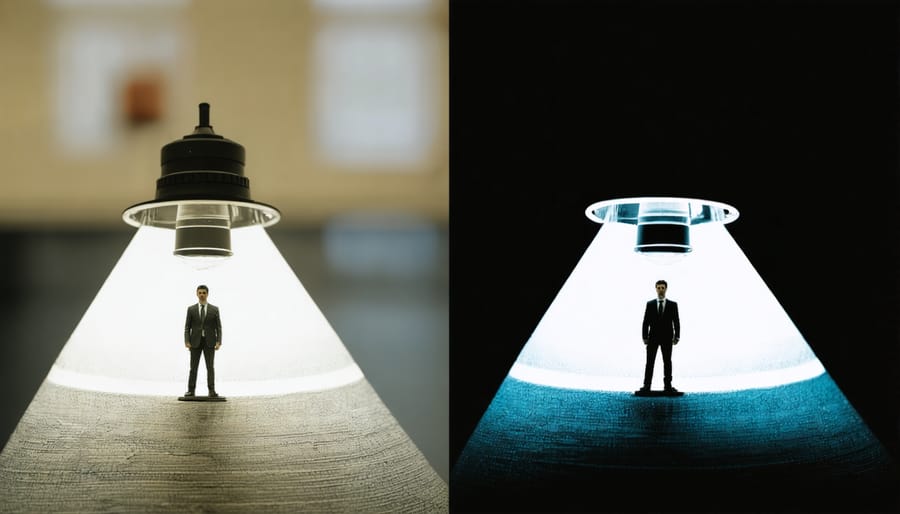
As we’ve explored throughout this journey into photographic artistry, the interplay of light and shadow serves as the fundamental language through which photographers tell their visual stories. The mastery of these elements isn’t just about technical proficiency – it’s about developing an eye for the subtle nuances that transform ordinary scenes into extraordinary images.
Remember that every photograph you take is an opportunity to experiment with these principles. Whether you’re working with natural light streaming through a window or crafting elaborate studio setups, the key lies in observation and intentional manipulation of light and shadow to create your desired effect. Don’t be afraid to break conventional rules – sometimes the most compelling images emerge from unexpected approaches.
The techniques we’ve discussed – from understanding the quality of light to manipulating shadows for dramatic effect – are merely starting points for your creative journey. As you practice, you’ll develop your own unique style and preferences. Pay attention to how different lighting conditions affect your subjects, and maintain a mental catalog of lighting scenarios that work well for various situations.
Consider keeping a photography journal to document your experiments with different lighting techniques. Note what works, what doesn’t, and why. This reflective practice will accelerate your learning and help you develop a more intuitive understanding of light and shadow manipulation.
Above all, remember that true artistry in photography comes from a combination of technical knowledge and creative vision. Don’t let technical perfection overshadow the emotional impact you want your images to convey. The most memorable photographs often balance both elements, creating images that not only demonstrate technical skill but also connect with viewers on an emotional level.


